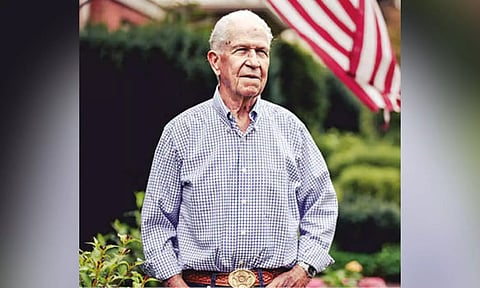

NEW YORK: He still remembers the first gunshot. For an instant, standing on the running board of the motorcade car, he entertained the vain hope that maybe it was just a firecracker or a blown tire. But he knew guns and he knew better. Then came another shot. And another. And the president slumped down.
For so many nights afterward, he relived that grisly moment in his dreams. Now, 60 years later, Paul Landis, one of the Secret Service agents just feet away from President John F.
Kennedy on that fateful day in Dallas, is telling his story in full for the first time. And in at least one key respect, his account differs from the official version in a way that may change the understanding of what happened in Dealey Plaza.
Landis has spent most of the intervening years fleeing history, trying to forget that unforgettable moment etched in the consciousness of a grieving nation.
The memory of the explosion of violence and the desperate race to the hospital and the devastating flight home and the wrenching funeral with John Jr. saluting his fallen father — it was all too much, too torturous, so much so that Landis left the service and Washington behind.
Until finally, after the nightmares had passed at last, he could think about it again. And he could read about it. And he realized that what he read was not quite right, not as he remembered it. As it turns out, if his recollections are correct, the much-discussed “magic bullet” may not have been so magic after all.
His memory challenges the theory advanced by the Warren Commission that has been the subject of so much speculation and debate over the years — that one of the bullets fired at the president’s limousine hit not only Kennedy but Gov. John B. Connally Jr. of Texas, who was riding with him, in multiple places.
Landis’s account, included in a forthcoming memoir, would rewrite the narrative of one of modern American history’s most earth-shattering days in an important way. It may not mean any more than that.
But it could also encourage those who have long suspected that there was more than one gunman in Dallas on Nov. 22, 1963, adding new grist to one of the nation’s enduring mysteries.
As with all things related to the assassination, of course, his account raises questions of its own. Landis remained silent for 60 years, which has fuelled doubts even for his former Secret Service partner, and memories are tricky even for those sincerely certain of their recollections.
A couple elements of his account contradict the official statements he filed with authorities immediately after the shooting, and some of the implications of his version cannot be easily reconciled to the existing record.
But he was there, a firsthand witness, and it is rare for new testimony to emerge six decades after the fact. He has never subscribed to the conspiracy theories and stresses that he is not promoting one now. At age 88, he said, all he wants is to tell what he saw and what he did. He will leave it to everyone else to draw conclusions.
“There’s no goal at this point,” he said in an interview last month in Cleveland, the first time he has talked about this with a reporter in advance of his book, “The Final Witness,” which will be published on Oct. 10. “I just think it had been long enough that I needed to tell my story.”